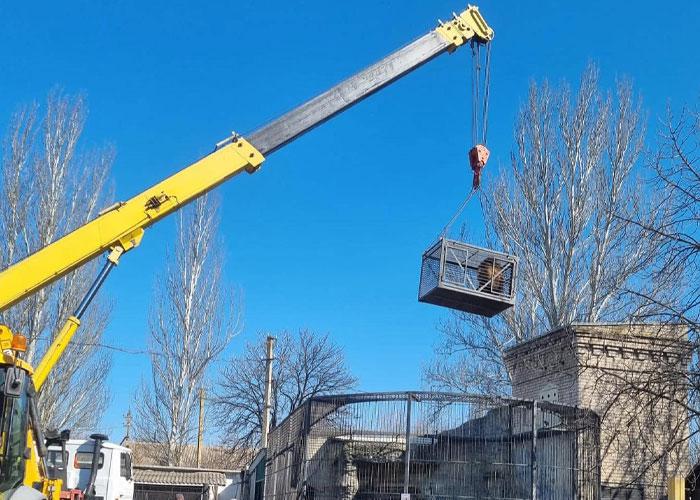Most of us associate Britain with the Queen, Big Ben, scones, crumpets (trust me, they’re not what you imagine them to be), afternoon tea, London Bridge, etc. But those of us who’ve lived there know that the country is full of the most insane, interesting, and kind-hearted people. Whether you meet someone with a combo of said qualities or someone displaying either one of them, the British sure know how to have a good time and provide some of the most interesting stories.
And boy, have I got a story for you today… A British war veteran has evacuated a lion and wolf from Ukraine after crowdfunding the money and driving the animals out of the country in the back of a minibus. Yeah. That happened. But as silly as this sounds, there is a very serious reason for acts like these to exist as they aid in saving the lives of those that are stuck at the mercy of the aggressor. Let’s get into it.
More info: Facebook
Image credits: Tim Locks
Tim Locks and two companions undertook a four-day mission to save the creatures from their enclosures 20 km from the frontline with Russian forces in the south east of the country.
The crew lifted the animals out of their enclosures via crane, placed them into a Ford Transit van and drove towards Romania, where they safely delivered the animals to a zoo in the northeastern city of Radauti. The 1,200-mile journey throughout a war-ravaged country is one to remember.
Image credits: Tim Locks
The protagonist of the story is Tim, a 45-year-old British war veteran, who previously fought ISIS alongside Kurdish Peshmerga forces in Iraq.
He was in Lviv at the time, aiming to provide aid to as many people as possible, which brings us to the story at present. Tim heard of the difficult situation regarding a lion and wolf from a conservationist he met in a hotel and he knew it’d be the job for him and his mates.
Image credits: Tim Locks
The team took the dimensions of the cages and worked out how the animals would fit inside the van. Stocking up on aid for the people still in Zaporizhzhia, including toiletries, nappies and baby formula, they headed out.
Driving around the clock and taking shifts behind the wheel, they experienced a variety of Ukrainian checkpoints on their 600-mile journey eastwards before arriving at the former visitor attraction.
Once there, they noticed that the lion, Simba, was already caged, while a vet sedated the wolf, Akela, before she was placed in another container.
Image credits: Tim Locks
Image credits: Tim Locks
A crane and a JCB digger were then used to load the animals into the back of the van. Tim told Metro that it took three hours to complete the job as the crane driver and digger driver didn’t speak a word of English, and they didn’t speak Ukrainian. Thankfully, there was an interpreter who translated everything and the cages were a perfect fit, leaving little room for anything else.
Tim recalled that as they were leaving the city, they were given a police escort and the air raid sirens were ringing out. They only had 35 minutes before the curfew started.
The whole situation was as surreal to them as it is for us to read: “We kept reminding each other that we’d got a lion and a wolf in the back of the van as we were driving and looking back to see that there they were, just over our shoulders.”
Image credits: Tim Locks
They posted an update mid-way to Romania, showing them attempting to feed the king of the jungle. As he describes it, “my buddy put his f’ing hand in the lion’s cage and gave the lion food” and then Tim continues to encourage him to put another big piece of meat in.
The men call the lion “good lad” as he approaches the offerings, inspects them and nibbles at them leisurely. He apologized to any lion experts if they were doing things wrong, explaining that it’d been the first time he’d ever carried a lion in his van. Well, that’s relieving, I suppose.
Imagine if you turned your head to look at the scenery and all you saw were lions in the backseats of people’s cars. Seems mad, but we digress; back to the story!

Image credits: Walt Disney Pictures
Driving amid heavy Russian bombardment of Ukrainian cities, they declared their cargo as ‘a lion and a wolf’ at checkpoints, one guard telling the men there was a war on and it was no time to joke around. Tim said that he took the officer to the side of the van, opened the door, and showed him this proper big lion, “like Aslan out of Narnia.”
Once they crossed the border to Romania, they met a vet who spent two hours completing paperwork. Then they set off to the zoo in the north-eastern city of Radauti. Police helped them drive non-stop, providing a blue-lighted escort as the trio gathered up hundreds more miles. They used a forklift and the help of 20 Romanians in a tricky operation to lift the animals into their new home.
Image credits: Tim Locks
“No one thought we would pull it off,” Tim said, but they managed to get the animals to safety and they seemed happy about it. So happy that they stayed behind for biscuits and tea, exploring more of the zoo.
They were hoping to aid more animals but it is becoming increasingly more difficult to move and aid across borders. In Tim’s words, there are plenty of teams looking after people, but strangely, no one else wanted to help the animals, so it was a job for them.
Not sure if it’s surprising that people can’t imagine carrying a live tiger and wolf in the back of their cars, but it sure does help to know that there are people like Tim who are up for the challenge.
Image credits:MFA of Ukraine
The reason why operations like these are a necessity is that zoos are getting attacked by Russian forces, leaving the animals stranded with little place to hide.
One zoo in Mykolaiv, close to where Tim and his friends went, has asked for international support to keep its animals alive after most of its staff were either evacuated or joined the military to fight Russian invaders.
Mykolaiv Zoo is operating in “wartime mode,” its director, Volodymyr Topchyi, said in a Facebook post earlier this month. He continued to say that every day they go to work, feed and clean the animals despite the howl of the air raid sirens.
Volodymyr asked people to consider purchasing e-tickets to the zoo to financially support it during the war. The park is home to polar bears, hippos, lions, wolves, elephants, zebras, primates and many other animals, according to its website, all of whom have become potential targets of war.
Image credits:MFA of Ukraine
The city has faced fierce shelling from Russian forces, the zoo being no exception, yet the director had decided to stay and help stressed animals.
In a video interview last week with Voice of America, Volodymyr said tickets to the zoo were sold out a month in advance and that he had been moved by the donations from around the world. They had also received a large donation of food and medical supplies from various zoos across Europe.
The European Association of Zoos and Aquaria said it was providing some financial aid to the zoo along with several others in Ukraine.
Image credits: UN Office for the Coordination of Humanitarian Affairs
The map shows the attacked areas of Ukraine by Russian forces. On the bottom of the map, near the Black Sea, you can see two areas underlined, showing the locations of both zoos mentioned in this story.
Even though the support provided is giving us hope for the better, there is a lot more that needs to be done in order to avoid unnecessary bloodshed, both animal and human.
Consider looking through means to support Ukraine in this difficult time with some resources listed here. Otherwise, I’d love to hear your thoughts. Would you be willing to take a lion or wolf in the back of your vehicle in order to save its life?
Also, consider typing out “dumplings” in the comments to show support for the people researching and writing the stories for your entertainment and good spirits. If we receive enough of these, I might buy some for me and my colleagues to share.
Anyone can write on Bored Panda. Start writing!
Follow Bored Panda on Google News!
Follow us on Flipboard.com/@boredpanda!




